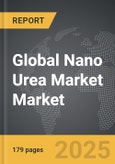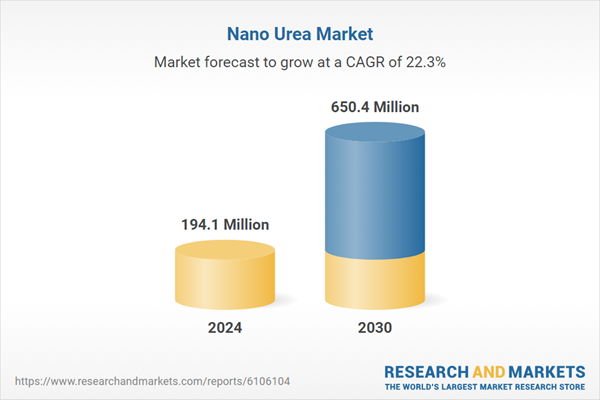Global Nano Urea Market - Key Trends & Drivers Summarized
Why Is Nano Urea Emerging as a Disruptive Input in Sustainable Agriculture?
Nano urea is a liquid fertilizer developed using nanotechnology to improve nitrogen delivery to crops with significantly lower application volumes compared to conventional urea. Traditional urea is known to suffer from inefficiencies due to leaching, volatilization, and runoff, resulting in nutrient loss and environmental damage. Nano urea addresses these challenges by enhancing nitrogen uptake efficiency at the foliar level, reducing application frequency while maintaining or improving crop yields.Its introduction aligns with global efforts to reduce chemical fertilizer dependency, minimize ecological harm, and optimize input costs in farming. By enabling targeted delivery at the cellular level, nano urea reduces the total amount of nitrogen needed per hectare. This contributes to better soil health, reduced greenhouse gas emissions, and improved water retention in agricultural ecosystems. Its adoption is particularly relevant in regions facing fertilizer shortages or strict environmental regulations.
How Is Technology Enhancing Efficacy and Application of Nano Urea?
Nano urea is manufactured using a process that involves coating nitrogen particles with nanoscale carriers to control their release and absorption. These nano-sized particles exhibit higher surface area, allowing faster and more uniform foliar absorption through stomata on plant leaves. Unlike bulk urea, which is applied to soil, nano urea is sprayed directly onto plant surfaces, bypassing traditional routes of nutrient loss.The formulation is typically water-based, non-toxic, and free from heavy metal residues, ensuring compatibility with organic and precision farming practices. Spray-based application ensures even coverage and rapid action. As digital farming technologies evolve, nano urea is being integrated with drone spraying systems, enabling farmers to optimize dosage across different field zones. Storage and transportation costs are also lower due to its compact liquid form, offering logistical advantages over bulk granular fertilizers.
Which Regions and Crop Systems Are Driving Adoption of Nano Urea?
Adoption is accelerating in agriculture-intensive countries seeking to enhance crop productivity while controlling input costs and pollution. Regions with fragmented land holdings and low fertilizer-use efficiency are early adopters, particularly in Asia. Governments and cooperatives are promoting nano urea through pilot programs, subsidies, and farmer training initiatives. Cereal crops like wheat, rice, and maize are key focus areas due to their high nitrogen demand and scale of cultivation.Horticultural crops, oilseeds, and pulses are also increasingly using nano urea for foliar feeding. Smallholder farmers benefit from its portability, ease of use, and reduced application requirements. Large-scale commercial farms exploring climate-resilient practices are testing nano urea as part of integrated nutrient management systems. Demand is also rising in regions with strict environmental oversight, where nutrient runoff limits are pushing a shift toward more efficient fertilizer practices.
Growth in the Nano Urea Market Is Driven by Several Factors…
Growth in the nano urea market is driven by several factors. Rising need for sustainable, efficient nitrogen fertilizers supports demand among farmers and policy makers. Increased awareness of soil degradation and fertilizer overuse prompts interest in alternatives with lower environmental impact. Advancements in nanotechnology enable precise formulation and consistent performance under diverse crop conditions. Expansion of drone-based and precision agriculture practices encourages foliar applications of liquid fertilizers. Public sector support through regulatory approvals, incentives, and demonstration projects accelerates commercialization. Finally, the cost savings from reduced fertilizer volumes, combined with improved yield outcomes, are encouraging wider adoption of nano urea in both conventional and progressive farming systems.Report Scope
The report analyzes the Nano Urea market, presented in terms of market value (US$). The analysis covers the key segments and geographic regions outlined below:- Segments: End-Use (Food Crops End-Use, Cash Crops End-Use, Horticulture Crops End-Use, Plantation Crops End-Use, Other End-Uses).
- Geographic Regions/Countries: World; United States; Canada; Japan; China; Europe (France; Germany; Italy; United Kingdom; Spain; Russia; and Rest of Europe); Asia-Pacific (Australia; India; South Korea; and Rest of Asia-Pacific); Latin America (Argentina; Brazil; Mexico; and Rest of Latin America); Middle East (Iran; Israel; Saudi Arabia; United Arab Emirates; and Rest of Middle East); and Africa.
Key Insights:
- Market Growth: Understand the significant growth trajectory of the Food Crops End-Use segment, which is expected to reach US$259.4 Million by 2030 with a CAGR of a 22.6%. The Cash Crops End-Use segment is also set to grow at 19.2% CAGR over the analysis period.
- Regional Analysis: Gain insights into the U.S. market, valued at $52.9 Million in 2024, and China, forecasted to grow at an impressive 29.8% CAGR to reach $155.7 Million by 2030. Discover growth trends in other key regions, including Japan, Canada, Germany, and the Asia-Pacific.
Why You Should Buy This Report:
- Detailed Market Analysis: Access a thorough analysis of the Global Nano Urea Market, covering all major geographic regions and market segments.
- Competitive Insights: Get an overview of the competitive landscape, including the market presence of major players across different geographies.
- Future Trends and Drivers: Understand the key trends and drivers shaping the future of the Global Nano Urea Market.
- Actionable Insights: Benefit from actionable insights that can help you identify new revenue opportunities and make strategic business decisions.
Key Questions Answered:
- How is the Global Nano Urea Market expected to evolve by 2030?
- What are the main drivers and restraints affecting the market?
- Which market segments will grow the most over the forecast period?
- How will market shares for different regions and segments change by 2030?
- Who are the leading players in the market, and what are their prospects?
Report Features:
- Comprehensive Market Data: Independent analysis of annual sales and market forecasts in US$ Million from 2024 to 2030.
- In-Depth Regional Analysis: Detailed insights into key markets, including the U.S., China, Japan, Canada, Europe, Asia-Pacific, Latin America, Middle East, and Africa.
- Company Profiles: Coverage of players such as AeroVironment Inc., Aero Sentinel, Aeryon Labs, Altavian Inc., BAE Systems plc and more.
- Complimentary Updates: Receive free report updates for one year to keep you informed of the latest market developments.
Some of the 32 companies featured in this Nano Urea market report include:
- Aries Agro Limited
- BASF SE
- CF Industries Holdings, Inc.
- Chambal Fertilizers & Chemicals Ltd
- Coromandel International Limited
- Deepak Fertilizers & Petrochemicals Corp Ltd
- Fertilizers and Chemicals Travancore Ltd (FACT)
- Gujarat State Fertilizers & Chemicals Ltd
- Hindustan Insecticides Ltd
- IFFCO (Indian Farmers Fertiliser Cooperative Ltd)
- Krishak Bharati Cooperative Ltd (KRIBHCO)
- Mangalore Chemicals & Fertilizers Ltd
- Mosaic Company
- National Fertilizers Limited
- Nagarjuna Fertilizers & Chemicals Ltd
- Nufarm Limited
- Nutrien Ltd.
- Rashtriya Chemicals & Fertilizers Ltd (RCF)
- Southern Petrochemical Industries Corporation Ltd (SPIC)
- Tata Chemicals Limited
- Yara International ASA
- Qatar Fertiliser Company (QAFCO)
This edition integrates the latest global trade and economic shifts into comprehensive market analysis. Key updates include:
- Tariff and Trade Impact: Insights into global tariff negotiations across 180+ countries, with analysis of supply chain turbulence, sourcing disruptions, and geographic realignment. Special focus on 2025 as a pivotal year for trade tensions, including updated perspectives on the Trump-era tariffs.
- Adjusted Forecasts and Analytics: Revised global and regional market forecasts through 2030, incorporating tariff effects, economic uncertainty, and structural changes in globalization. Includes historical analysis from 2015 to 2023.
- Strategic Market Dynamics: Evaluation of revised market prospects, regional outlooks, and key economic indicators such as population and urbanization trends.
- Innovation & Technology Trends: Latest developments in product and process innovation, emerging technologies, and key industry drivers shaping the competitive landscape.
- Competitive Intelligence: Updated global market share estimates for 2025, competitive positioning of major players (Strong/Active/Niche/Trivial), and refined focus on leading global brands and core players.
- Expert Insight & Commentary: Strategic analysis from economists, trade experts, and domain specialists to contextualize market shifts and identify emerging opportunities.
Table of Contents
Companies Mentioned (Partial List)
A selection of companies mentioned in this report includes, but is not limited to:
- Aries Agro Limited
- BASF SE
- CF Industries Holdings, Inc.
- Chambal Fertilizers & Chemicals Ltd
- Coromandel International Limited
- Deepak Fertilizers & Petrochemicals Corp Ltd
- Fertilizers and Chemicals Travancore Ltd (FACT)
- Gujarat State Fertilizers & Chemicals Ltd
- Hindustan Insecticides Ltd
- IFFCO (Indian Farmers Fertiliser Cooperative Ltd)
- Krishak Bharati Cooperative Ltd (KRIBHCO)
- Mangalore Chemicals & Fertilizers Ltd
- Mosaic Company
- National Fertilizers Limited
- Nagarjuna Fertilizers & Chemicals Ltd
- Nufarm Limited
- Nutrien Ltd.
- Rashtriya Chemicals & Fertilizers Ltd (RCF)
- Southern Petrochemical Industries Corporation Ltd (SPIC)
- Tata Chemicals Limited
- Yara International ASA
- Qatar Fertiliser Company (QAFCO)
Table Information
| Report Attribute | Details |
|---|---|
| No. of Pages | 179 |
| Published | December 2025 |
| Forecast Period | 2024 - 2030 |
| Estimated Market Value ( USD | $ 194.1 Million |
| Forecasted Market Value ( USD | $ 650.4 Million |
| Compound Annual Growth Rate | 22.3% |
| Regions Covered | Global |









